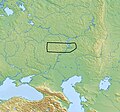 | Novotitarovskaya culture (miswritten Novotitorovka culture), was a Bronze Age archaeological culture which flourished in the North Caucasus ca. 3300–2700... 3 KB (197 words) - 08:42, 25 November 2023 |
 | The Sintashta culture is a Middle Bronze Age archaeological culture of the Southern Urals, dated to the period c. 2200–1900 BCE. It is the first phase... 46 KB (4,900 words) - 19:11, 27 April 2024 |
 | Kurgan hypothesis (redirect from Kurgan culture) prehistoric cultures, including the Yamnaya (or Pit Grave) culture and its predecessors. In the 2000s, David Anthony instead used the core Yamnaya culture and... 34 KB (3,825 words) - 14:41, 30 April 2024 |
 | apparently influenced it. To the north is the Yamna culture, including the Novotitarovskaya culture (3300—2700), which it overlaps in territorial extent... 22 KB (2,637 words) - 10:03, 11 April 2024 |
 | The Samara culture is an Eneolithic (Copper Age) culture dating to the turn of the 5th millennium BCE, at the Samara Bend of the Volga River (modern Russia)... 13 KB (1,332 words) - 13:13, 2 May 2024 |
 | 49.551376°E / 52.741254; 49.551376 The Khvalynsk culture is a Middle Copper Age Eneolithic culture (c. 4,900 – 3,500 BC) of the middle Volga region.... 14 KB (1,726 words) - 10:01, 11 April 2024 |
 | Iranian peoples (section Sintashta–Petrovka culture) The Sintashta culture, also known as the Sintashta–Petrovka culture or Sintashta–Arkaim culture, is a Bronze Age archaeological culture of the northern... 108 KB (11,679 words) - 01:18, 21 April 2024 |
 | The Abashevo culture (Russian: Абашевская культура, romanized: Abashevskaya kul'tura) is a late Middle Bronze Age archaeological culture, ca. 2200–1850... 25 KB (2,936 words) - 17:15, 15 April 2024 |
 | The Andronovo culture is a collection of similar local Late Bronze Age cultures that flourished c. 2000–1150 BC, spanning from the southern Urals to the... 63 KB (7,041 words) - 15:09, 4 May 2024 |
 | Sarmatians (redirect from Sarmatian culture) of the Eurasian Steppe, the Sarmatians were part of the wider Scythian cultures. They started migrating westward around the fourth and third centuries... 80 KB (8,681 words) - 19:12, 19 April 2024 |
 | Cimmerians (redirect from Kimmerian culture) other early nomadic cultures of the Eurasian steppe and forest steppe which existed before the 7th century BC, such as the Aržan culture, so that these various... 142 KB (17,035 words) - 21:09, 7 May 2024 |
 | The Usatove culture (Usatove in Ukrainian, Usatovo in Russian) is an Eneolithic group of the North Pontic region with influences from the Cucuteni–Trypillia... 8 KB (703 words) - 13:15, 2 May 2024 |
Afanasievo culture, or Afanasevo culture (Afanasevan culture) (Russian: Афанасьевская культура Afanas'yevskaya kul'tura), is an early archaeological culture of... 62 KB (6,043 words) - 04:42, 11 May 2024 |
 | Kurgan culture Steppe cultures Bug–Dniester Sredny Stog Dnieper–Donets Samara Khvalynsk Yamnaya Mikhaylovka culture Novotitarovskaya culture Caucasus... 2 KB (105 words) - 22:54, 27 April 2024 |
 | The Sredny Stog culture (Russian: Среднесто́говская культу́ра, romanized: Srednestogovskaja kul'tura, Ukrainian: Середньостогівська культура,... 22 KB (2,515 words) - 13:14, 2 May 2024 |
 | The Mikhaylovka culture, Lower Mykhaylivka culture (3600—3000 BCE) is a Copper Age archaeological culture which flourished on the Pontic steppe from 3600... 2 KB (228 words) - 08:39, 25 November 2023 |
 | The Dnieper–Donets culture complex (DDCC) (ca. 5th—4th millennium BC) is a Mesolithic and later Neolithic archaeological culture found north of the Black... 22 KB (2,306 words) - 10:02, 11 April 2024 |
 | Anatolian peoples (section Culture) October 2012. Fortson, IV, Benjamin W. (2011). Indo-European Language and Culture: An Introduction. John Wiley & Sons. ISBN 978-1-4443-5968-8. Retrieved... 11 KB (1,040 words) - 07:29, 27 November 2023 |









